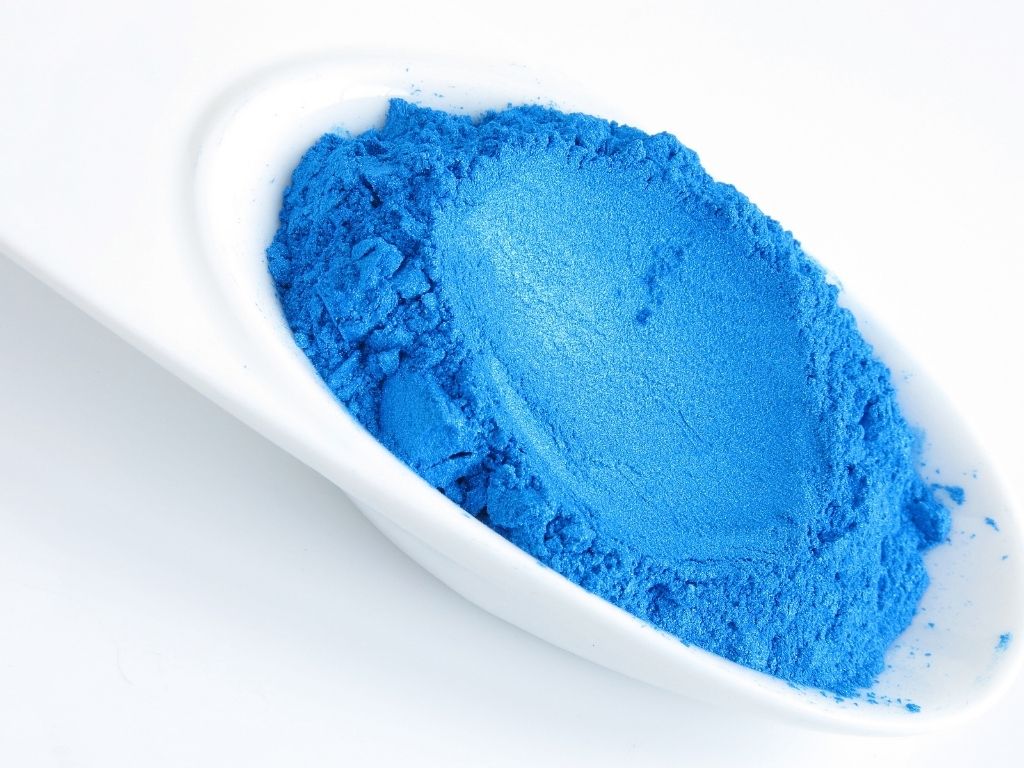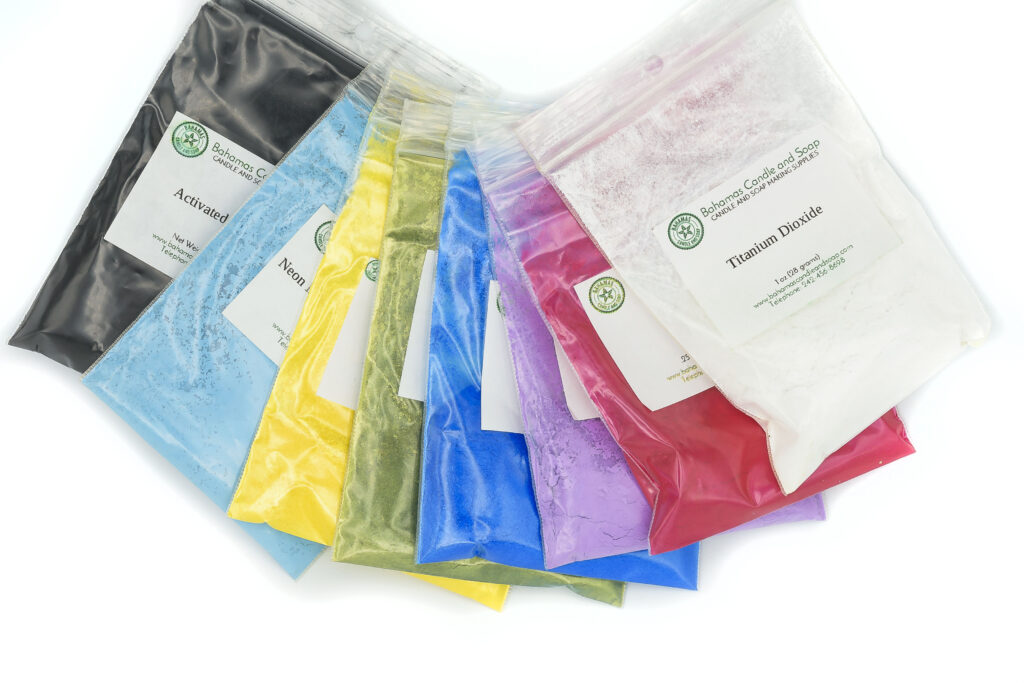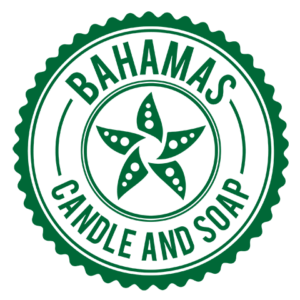If it is your first time or 100th time making melt and pour soap, you probably wondered what else can I do to spruce up the look of this soap. Most often adding color is good enough to make your soap stand out but then the question arises what colors should I use? and what would give the the best results.
So how do you color melt and pour soap? There are actually a few methods and coloring melt and pour soap. You can use colorants such as mica, pigments, oxides, lab colors, natural colors and the unconventional means of using crayons and Kool Aid. Add any of these to your melted melt and pour soap until you get the color you desire.

Adding color to your melt and pour soap
When it comes to adding color to your melt and pour soaps you have options that you may want to try out one at a time or run a full test to see which ones you prefer to use in the long term. The list of potential colorants are easy to find you can browse our list of colorants in our STORE area.
With all the options avaoilable when it comes to coloring your soap the good news or bad depending on your perspective, is that there is no hard and fast rule to adding color to your soap. There are however guides that you should observe and then make notation of your process if you get a good result.
A general rule to adding color to melt and pour is to start with 1/2 tsp per pound of soap base. This is your starting line. Mix the color well and use your alcohol spray to get rid of any bubbles. If the color is not to your liking you can add more as you go 1/2 tsp at a time.
Take note however that adding too much colorant can cause the color to wash off on your hand to the touch which means it will discolor washcloths and even colorize your skin. This is why you must add in 1/2tsp increment and take note of your amount for your records.
Another guideline to coloring your melt and pour soap is to mix your colorant either in glycerin or rubbing alcohol prior to adding it to your soap base. This will help disperse the colorant powder and make it easier to be incorporated in to the soap.
Oxide and pigments for melt and pour soap
Oxides and pigment colors are created colorants that resemble earth tones in most cases. They come in two types Mineral and Organic pigments. The words are not meant to indicate that they are natural colorants as they are not but to indicate the color tones they represent.
Mineral pigments are colors such as rust, silver or gold while Organic pigments represent more natural colors found in nature. They are all developed in a laboratory to mimic these colors. They often contain natural ingredients but they are developed to remove any contaminates such as led or iron that may occur in natural rocks.
The versatility of oxides and pigments are that the color can be adjusted by adding more or less to your soap. Less color gives you a muted pastel color while adding more tends to give you a strong punchy color.
Its good to know however that pigments and oxides are not soluble in water and hence are not soluble in melt and pour soap bases. Instead they disperse withing the soap base and that is how the soap is colored. We recommend you disperse these types of colorants in rubbing alcohol first before adding to your soap. The heat of the soap will evaporate the alcohol leaving the dispersed color.

Micas for melt and pour soap
Micas and Pigments get confused as persons often think the pigments are developed from the earth natural when in fact mica are made from a type of naturally occurring rock. The most common type of mica is the muscovite mica and is used in soap making because its actually clear.
This rock is mined and thin layers are sourced, cleaned, sterilized, broken up into tiny pieces and dyed to various colors. It is this dying process that makes micas so versatile and able to be offered in so many colors.
Because Micas are made from this thin rock you may see them shine or spots of glitter in your soap as you look at it in the light. Unfortunately some mica colors do fade with time as it is just a dye. This is something you will have to take note of over time.
Like pigments and oxides it can help to disperse the mica before adding it to your melt and pour soap but its not necessary. The pieces of mica do not clump together like pigments and are easily dispersed in the liquid soap.
Lab Colors for melt and pour soap
Lab colors are well… created in a lab. This makes the variety of colors very divers in what can be used for your melt and pour soap.
The beauty of using lab colors is that they are already at a liquid state however they are very concentrated and will need to be diluted before use. I have known persons who have used the concentrated lab color in melt and pour soap without any adverse affect.
Using lab colors in this manner, you will have to test to find out what you like, diluted or concentrated.
Lab colors are often diluted using distilled water and then with the use of a dropper added to your soap. Undiluted lab color can be used the same way however because it is concentrated far less will be needed. Be careful of adding to much concentrated lab color to your soap especially at cooler temperatures.
When you melt and pour soap begins to cool down it is harder to add lab colors to it. The color becomes inconsistent and may be too concentrated in certain areas. Just be sure to keep your soap at a manageable temperature when adding lab colors.
Natural Colors for melt and pour soap
Natural colors are all the rage in the twenty first century. Persons are becoming more health and environmentally conscious hence they prefer more natural items.
Using natural colorants meets this demand for the more environmentally inclined person by using powdered colorants made primarily from roots and other plant matter. Natural colorants can also be purified clays such as kaolin clay and rose clay.
The drawback to using natural colorants is that they are not very vibrant. Many natural colors will give your soap a pastel muted look rather than a bright vibrant look. You can however mix mica with your natural colors for a better color.
To add natural colorants to your melt and pour mix it with rubbing alcohol or glycerin. Some people also use distilled water as a mixing agent and then add the mixed batch to the melt and pour soap.
Other methods of coloring your soap
Crayon, Kool Aid and color Blocks are other options for coloring your melt and pour soap. Please note the use of crayon is not condoned by Bahamas Candle and Soap and it is also not encouraged by Crayola. You can read a bit about their policy of using their product in cosmetics HERE.
If you choose to use crayon then you take responsibility for doing so. other persons who have used crayons for color advise that they shave parts off and add it to heated melt and pour soap base until they get the desired color affect.
As for kool aid they company policy seems not be clear as persons use it to dye their hair various colors. Kool Aid is use muck like the other powdered colorants. Add it to glycerin or rubbing alcohol before adding to your soap base. The affects of using this method is unknown to me. I cannot advise any further on it.
Color blocks are something that has been making its rounds in the soaping community. A color block is a mixture of mica or pigments mixed with a soap base and lab colors to produces easy to use colorants.
Shave pieces of the color block and to you hot soap base until you get the color you desire.
Colorant type guide for adding color to melt and pour soap
| Colorant | Colorant amount to add to melt and pour soap |
|---|---|
| Pigment | 1tsp of pigment to 1tbs of glycerin or rubbing alcohol. Add to soap 1/4tsp at a time . |
| Color Block | Add small shavings to hot melt and pour and stir until you get desired color. |
| Mica | 1tsp of mica directly to the heated melt and pour soap. |
| LAB color | Use a dropper or pipette to add one drop at a time and stir for desired color. |
| Natural Colorant | 1tsp of pigment to 1tbs of glycerin or rubbing alcohol. Add to soap 1/4tsp at a time. |
Problems with adding color
The useage of various products and methods for adding color to your melt and pour soap are diverse however there can be some problems with some of them.
Color bleeding is a very common issue when it comes to melt and pour soaps. This happens when you add a colorant that is water soluble but not oil soluble. This causes the color to bleed into your soap and run throughout your other colors overall soap.
The best way to avoid this is to use either oil soluble colorants or one that can be easily dispersed without clumping together. Remember dispersed color doesn’t bond with the soap it gives the illusion of color because its suspended in the soap.
The best non bleeding colorants to consider are oxides and micas. Just remember to disperse them in alcohol or glycerin first.
Can I use food coloring for soap?
This portion was separated because this is a common question. The answer is yes you can use food coloring for soap making however there are some drawbacks.
Food coloring is considered FD&C color which means its regulated by the FDC as safe however its good to know that food safe does not mean skin safe. You can read a bit more on colors at the FDC website
A potential issue with using food coloring is that most often they bleed in the soap and when in use they can transfer to your skin and your wash cloth. Many food coloring colors fade fairly quickly in soap and it requires extensive test to find out what works and what doesn’t.
To color or not to color
When it comes to coloring melt and pour soaps you have many options. Try a few of them to find out what you prefer and will most likely use for your soaps.
Remember there is no right or wrong way add colorants to your soap hence its up to your creativity to figure out what you like.
Recent Posts
Best Practices for Using, Storing, and Keeping Soap Molds for a Long Time
Soap making can be a rewarding and creative pursuit, allowing artisans to craft unique products while exploring their artistic side. One of the most critical components of this process is the soap...
Recommended Soap Molds Soap making can be an exciting hobby or even a profitable business but you wont get very far if you make a batch of soap and have no way to shape and mold it. This is where...
